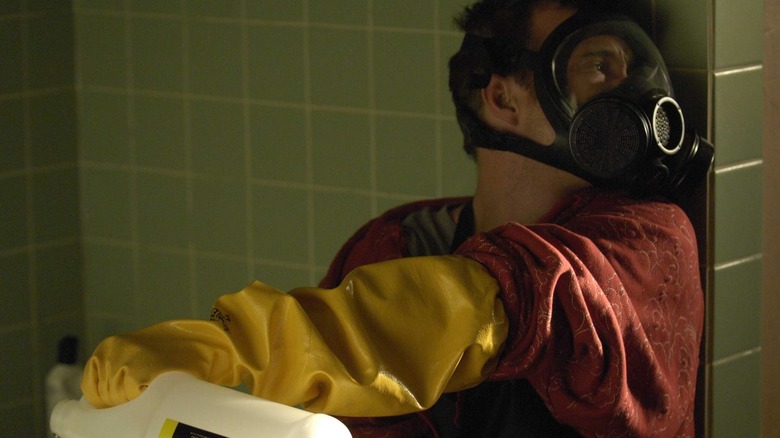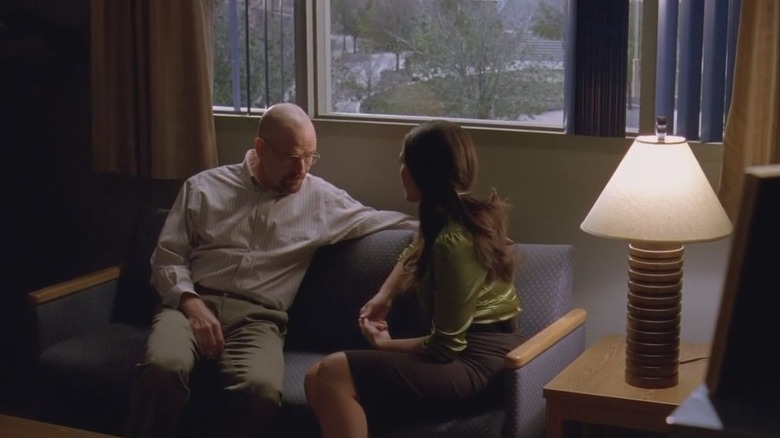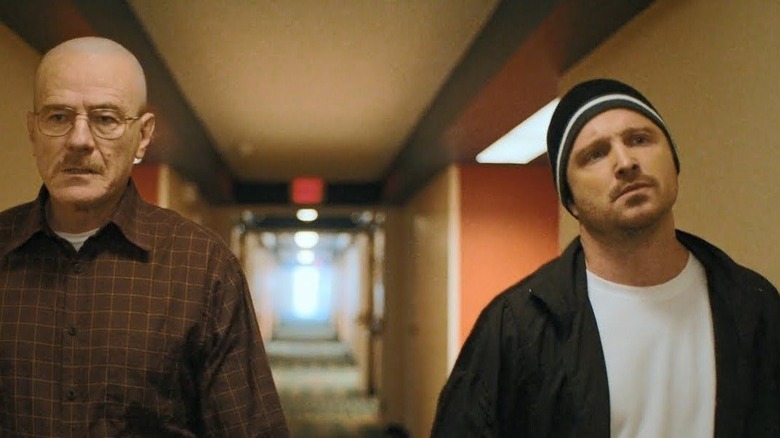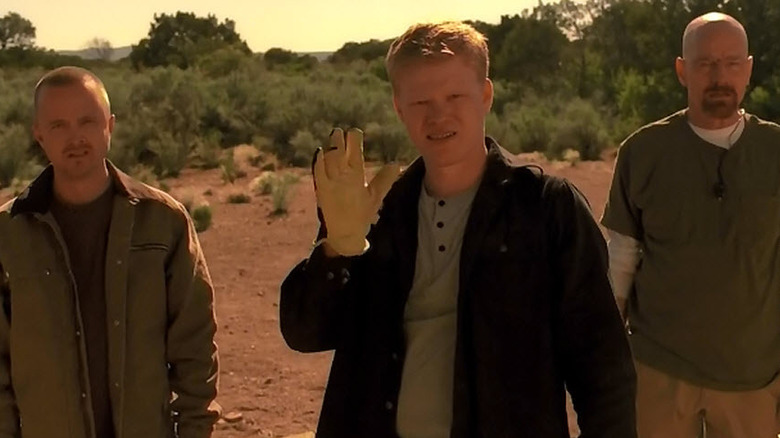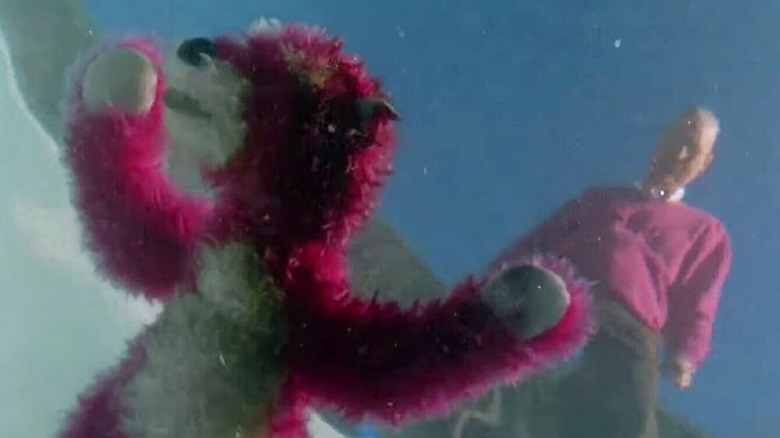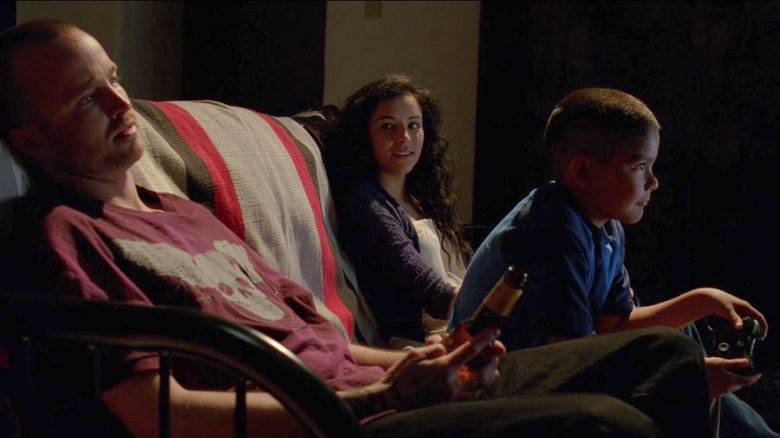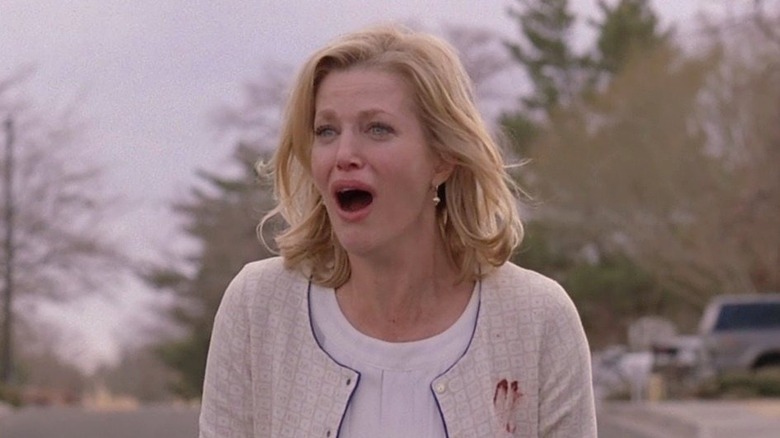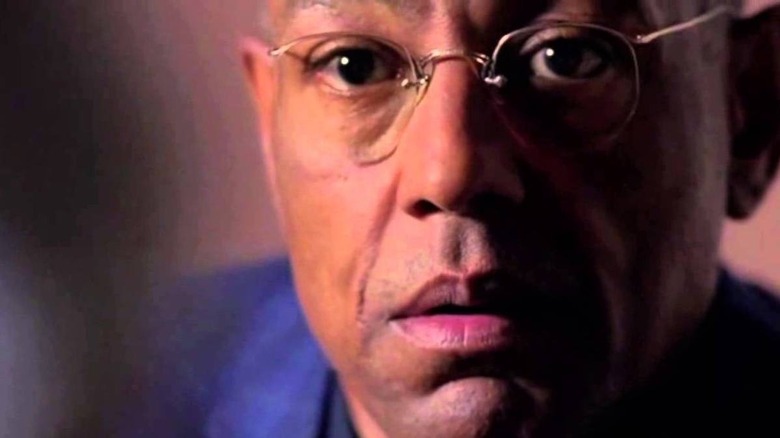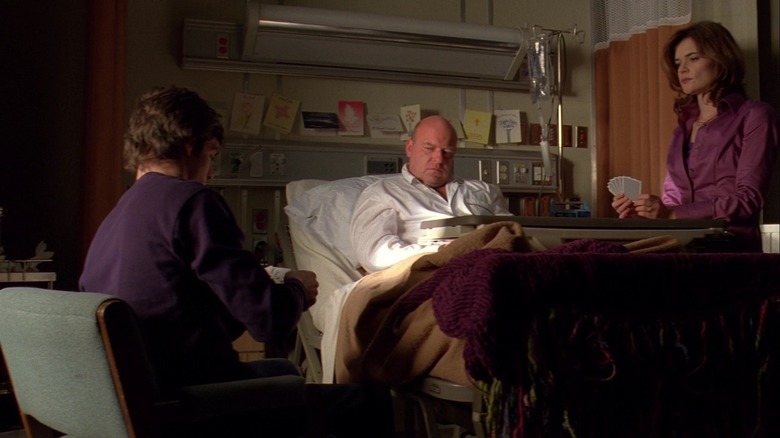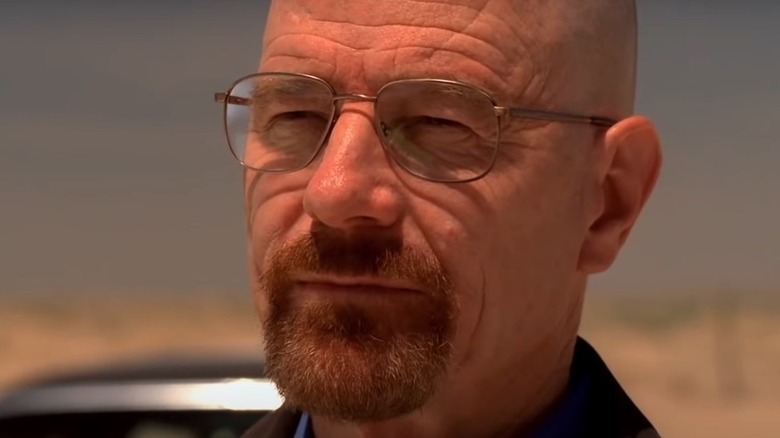Questionable Things In Breaking Bad We All Ignore
"Breaking Bad" is a monumental TV drama. It's one of the best to ever do it — an almost perfect TV show that excels in tense, character-driven storytelling. Without caring an iota about the greater story that follows the rise and fall of Walter White (Bryan Cranston), there are still so many excellent moments from the show. Jesse Pinkman (Aaron Paul) starts out as comic relief but ends up being the underdog of the show. And who can forget the show's numerous iconic nuanced villains like Gus Fring (Giancarlo Esposito) and Mike Ehrmantraut (Jonathan Banks)? All five seasons excel in humor, tension, and epic tragedy.
But just because "Breaking Bad" is a rollercoaster of a show doesn't mean it doesn't slip up. Whether it's some noticeable production inconsistency or an unbelievable departure from reality, a handful of moments stretch our suspension of disbelief. In one way or another, these are all questionable scenes and moments from "Breaking Bad" we ignore or choose to forget.
Hydrofluoric acid wouldn't burn through a bathtub
One of the first of many "holy crap!" moments in "Breaking Bad" is when a tub bursts through the ceiling down to where Jesse and Walt are standing on the floor below. This is after Jesse foolishly tries to dispose of a body by dissolving it in hydrofluoric acid ... in the upstairs bathtub. This move was inspired by Walter's scientific method of corpse disposal, implemented just episodes earlier in Season 1.
In reality, this moment could never happen. This was proved by "MythBusters" in 2013 (via Today). In fact, hydrofluoric acid doesn't quite have strong enough properties to eat through organic matter the way Walt seems to think it does. It works just fine in his world, but in our reality, this chemical does not have the destructive properties required to dissolve a body, let alone an entire floor. At least Jesse would've still had a working shower.
The pilot has a continuity error involving Walter's pants
While "Breaking Bad" gracefully calls back to its pilot in one of the final episodes, it wasn't always so carefully crafted. The pants that Walter wore in the pilot became as important as the pants he didn't wear (at least considering how much a promotional image of an old teacher in his underwear made early "Breaking Bad" marketing material stand out). The same pants that reappear in Season 5 (via Reddit) are shown in the show's very first episode blowing in the wind. They land on the ground, and the iconic meth-lab RV drives over them in the final moments of the silent but stunning intro.
At the end of the pilot, we see the moment where Walt throws his pants out of the very RV that is supposed to pass them. Continuity-wise, this doesn't seem very well thought out. Still, this kind of mistake is a rarity for such an excellent series.
Walt tries to kiss his principal, Carmen
In retrospect, a lot is made of Walt's faithfulness to his wife, Skyler. After she cheats on him with Ted — and even after she and Walt are separated — we don't see Walt with another woman. While he ultimately lets his personal greed get the better of him, Walt is fueled by a love of his family. So it is weird when the show tries to undermine this character trait in the 1st season when Walt tries to kiss Carmen (YouTube).
Carmen, the principal at the high school where Walt works, is a friend of the White family and in a crisis of identity. In an awfully cringe moment meant to signify to the audience that Walter White is beginning to lose his way, he attempts to make a move on her. It. However, putting the whole series in perspective, this moment feels more like a Season 1 characterization misstep. Walter did a lot of terrible things, but most of them felt like decisions he could rationalize to himself. Conversely, this brief moment of infidelity doesn't contribute to the image of Walt that is so vital to the character's arc.
Pure is not blue
While "Breaking Bad" is a mostly grounded drama, it takes a few silly liberties that turn into the ridiculous. The world of making meth, for one, is not as extravagant as the show makes it seem, and Jesse's trademark chili powder meth is so far from reality that it actually makes the joke funnier. But what's really questionable is the blue meth that Walt and Jesse peddle.
The substance is supposedly as pure as it gets, but according to Live Science, pure meth is typically white or clear. It is not outside the realm of possibility, but if anything, a blue-tinted meth would be less pure than what Walt claims his product is. At over 99% purity, Heisenberg's drugs would have to be a translucent white. It is a fun artistic flourish for the characters, but that distinctive blue hue is purely a thing of fiction.
Methylamine is not the rare substance Breaking Bad makes it out to be
As Jesse and Walt scale up their business in the 2nd and 3rd seasons of "Breaking Bad," a chemical precursor substance becomes a key source of tension. As greed and ambition make the cooks richer and Walt expands the Heisenberg empire, procuring methylamine becomes a bigger plot point and an increasing point of tension that builds up until the final season.
The payoff comes in the form of "Dead Freight," a memorable episode from the first half of Season 5 where Walt, Jesse, and Mike have to rob a train full of the stuff. It's one of the best episodes of "Breaking Bad" and has a shocking ending on top of a thrilling heist. In reality, though, methylamine isn't that hard to get a hold of — the substance can be manufactured using chemicals that can be acquired at an over-the-counter pharmacy or at your local Home Depot (via The Washington Post).
The Season 2 twist still seems a bit over the top
When ranking every season of "Breaking Bad," Season 2 comes in last. Every season of this masterful show has its merits, though, and Jane dying so soon made us realize she is actually a pretty compelling character — we wish she was able to live through more. Still, Season 2 drags in spots, and what's most irksome is the slow build-up foreshadowing a big finale reveal. In reality, the end of Season 2 is a bit of a letdown.
Throughout the season, the show cuts to imagery of a disheveled pink teddy bear floating in a pool. In the finale, "ABQ," we learn that this is wreckage from two airplanes that crash above Walter's house. Not only that, but this already questionable cosmic twist is made a bit more unbelievable: It is Jane's dad, an air traffic controller, who causes the crash due to distractedness immediately following his daughter's death. This implicates Walt not just in the death of Jane but also in the over 100 others that spring from that one.
How does Walt poison Brock?
In Season 4 of "Breaking Bad," Jesse gets romantically involved with a woman named Andrea (Emily Rios). She has a son, Brock, who ends up in the hospital near the end of the season due to poisoning. It is very heavily implied that Walt poisoned Brock to make Jesse more open to manipulation, and this is confirmed in the second half of Season 5 when Jesse finds out and confronts Walt about it over the phone.
What still bothers fans is the logistics of the whole situation (via Reddit). How did Walt find a way to slip the ricin to Brock? The truth is ambiguous, and there was never really meant to be a clear answer. When asked about it at a 2013 Comic-Con panel, creator Vince Gilligan said (per Digital Spy), "It was improbable, perhaps, but not impossible," and that his best guess was "[Walt] probably crushed some of the stuff up, put it in a juice box, got into Brock's school somehow."
The show has been criticized for its lack of deep female characters
While the spin-off drama "Better Call Saul” has been praised for its unexpected birth of a feminist icon (via Bustle), "Breaking Bad" didn't have a Kim Wexler (Rhea Seehorn). In fact, the female characters on the show are often derided by fans for being annoying. Skyler White is especially hated by the show's largely male fanbase (via Esquire), while other more likable women tend to not stick around too long before they get killed off. It's a media trend that is not unique to "Breaking Bad," but the show does occasionally dip into tropes that reinforce gender stereotypes.
The show is admittedly a critique of masculinity, but it's compared unfavorably to other contemporary dramas like "The Sopranos" (via The Guardian). Female critics especially have dug into this perception of the show and how, regardless of character morality, "Breaking Bad" lacks any real women to latch onto and become invested in the same way you can with Walt, Jesse, and numerous other men on the show.
Gus' death was cinematic but unrealistic
It's undeniable that the climactic "Face Off" that ends Season 4 is one of the best episodes of "Breaking Bad." The way Gus goes out in the explosion that Walt schemes to go off in the hospital where the crime lord is staying is unforgettable, and in the villain's final moments, he stumbles into the frame, face blown halfway to heck. Not quite dead, he adjusts his tie one last time before falling over, defeated by Heisenberg.
The moment is iconic, without a doubt, but some fans argue the believability. It is true that in his state, Gus is not missing any vital organs, but the likelihood that he doesn't die in the explosion immediately is extremely low. It's virtually impossible the situation would have played out in as dramatic a fashion as it did, but that final shot gives viewers much-needed catharsis, delivering the pay-off to the tension built up across the entire season.
The DEA should have paid for Hank's physical therapy
After Hank gets out of the hospital following his confrontation with the Salamanca twins (aka "the Cousins"), he needs a lot of expensive physical therapy to get back on his feet. In order to get him walking again, Walt and Skyler approach Hank and Marie and make up a phony story about Walt having the money from gambling winnings.
What doesn't make sense is why Hank and Marie had to seemingly pay well beyond their means for this therapy. Surely his job at the DEA sports a good salary, but more importantly, Hank should have pretty good government health care. Sure, he may still have bills to pay after the intensive hospital care he received, but nothing extreme enough to have to go to Walt. Instead, this moment is used to ratchet up the tension between Hank and Walter. It's still a while until Hank finds out about Heisenberg, but this complicates the power dynamic for the time being.
Walter gets a group of immigrant women deported
Until the show's final season, Walter White is a character who pushes the boundaries of his morality. He does a lot of bad things before he meets his end, but one of the most evil things Walter White does before he goes completely Scarface is get a group of immigrants deported. This Season 4 moment is a grave reminder that Walter is not in this for others but for himself. He sees the horrific consequences of his actions and decides to continue on his crusade regardless, and this development is one of the most glaring signs of the character's fall.
In the Season 4 episode "Cornered," Walt pays three cleaning women from the laundromat to help him clean the lab after Jesse is pulled away on assignment from Mike. When Gus inevitably finds out about this questionable decision, he deports the three immigrant workers. They could have very well been killed, but regardless, the repercussions of his actions are more than any good person could have taken without a massive weight on their conscience.

